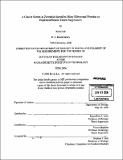| dc.contributor.advisor | Jacqueline A. Lees and Nancy Hopkins. | en_US |
| dc.contributor.author | Lai, Kevin | en_US |
| dc.contributor.other | Massachusetts Institute of Technology. Dept. of Biology. | en_US |
| dc.date.accessioned | 2007-11-15T19:55:06Z | |
| dc.date.available | 2007-11-15T19:55:06Z | |
| dc.date.copyright | 2006 | en_US |
| dc.date.issued | 2006 | en_US |
| dc.identifier.uri | http://dspace.mit.edu/handle/1721.1/35090 | en_US |
| dc.identifier.uri | http://hdl.handle.net/1721.1/35090 | |
| dc.description | Thesis (Ph. D.)--Massachusetts Institute of Technology, Dept. of Biology, 2006. | en_US |
| dc.description | Includes bibliographical references. | en_US |
| dc.description.abstract | A collection of over 500 lines of zebrafish (Danio rerio), each heterozygous for a recessive embryonic lethal mutation caused by a retroviral insertion, was screened for lines that displayed early mortality and externally visible tumors. Among such tumor-prone lines identified was one in which the known human tumor suppressor gene, neurofibromatosis type 2 (NF2), was mutated. This validated the screening approach, as well as confirmed the human relevance of the zebrafish system in the study of cancer. Surprisingly, all of the remaining tumor-prone lines identified in the screen were ones in which a ribosomal protein (rp) gene was mutated. In total, 17 of 28 rp heterozygous lines were found to be predisposed to rare tumors, especially zebrafish malignant peripheral nerve sheath tumors (zMPNST). Though the precise molecular mechanism of tumorigenesis in rp heterozygous lines remains elusive, we have demonstrated that these rps are haploinsufficient tumor suppressors based on two lines of evidence: (1) The retroviral insertion causes a loss of function of the rp gene, as evidenced by a reduction in mRNA encoding the rp and a disruption of ribosomal integrity in the homozygous rp mutants; | en_US |
| dc.description.abstract | (cont.) and (2) the wild-type allele is not lost or mutated in the tumors arising in rp heterozygotes. Haploinsufficiency of certain rps could lead to tumorigenesis either because a key extraribosomal function of these rps is compromised or global protein synthesis is impaired due to insufficient production of ribosomal subunits. We have found evidence in support of the latter hypothesis: Heterozygotes from all tumor-prone rp lines are growth-impaired, suggesting that a primary defect in global protein translation predisposes these fish to the development of tumors. This work has succeeded in identifying a novel class of haploinsufficient tumor suppressors, the ribosomal proteins, whose role in human cancers is as yet unknown. This demonstrates the powerful utility of the zebrafish as an ideal organism for genetic screens as well as a model in which to study human diseases. | en_US |
| dc.description.statementofresponsibility | by Kevin Lai. | en_US |
| dc.format.extent | 161 leaves | en_US |
| dc.language.iso | eng | en_US |
| dc.publisher | Massachusetts Institute of Technology | en_US |
| dc.rights | M.I.T. theses are protected by copyright. They may be viewed from this source for any purpose, but reproduction or distribution in any format is prohibited without written permission. See provided URL for inquiries about permission. | en_US |
| dc.rights.uri | http://dspace.mit.edu/handle/1721.1/35090 | en_US |
| dc.rights.uri | http://dspace.mit.edu/handle/1721.1/7582 | |
| dc.subject | Biology. | en_US |
| dc.title | A cancer screen in zebrafish identifies many ribosomal proteins as haploinsufficient tumor suppressors | en_US |
| dc.type | Thesis | en_US |
| dc.description.degree | Ph.D. | en_US |
| dc.contributor.department | Massachusetts Institute of Technology. Department of Biology | |
| dc.identifier.oclc | 71331962 | en_US |
